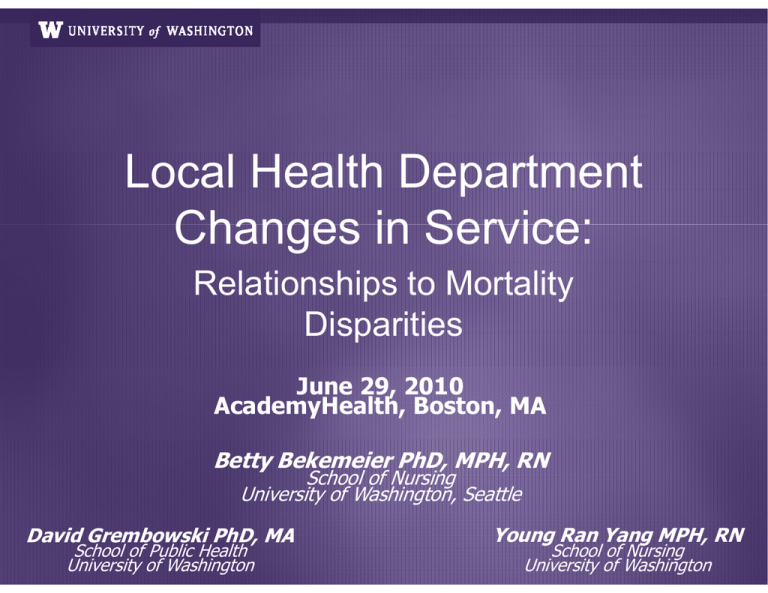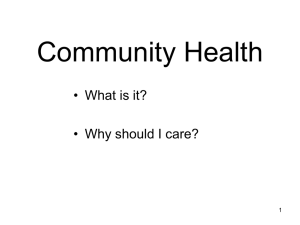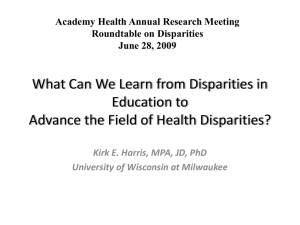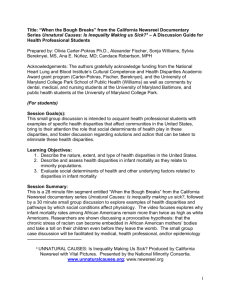Local Health Department Changes in Service: Relationships to Mortality p
advertisement

Local Health Department Changes in Service: Relationships p to Mortality y Disparities June 29, 2010 AcademyHealth, Boston, MA Betty Bekemeier PhD, MPH, RN School of Nursing University of Washington, Seattle David Grembowski PhD, MA School of Public Health University of Washington Young Ran Yang MPH, RN School of Nursing University of Washington Background • “…not ot o only ya are e we e ge generally e a y not ot e eliminating at g disparities, …we are not even [significantly] reducing them them.” (Orsi et al, 2009) • “Dramatic shifts” in funding (Lenaway et al., 2006) • Trends toward more population-level service (Keene, 2003) • Little evidence of impact of service changes Research Question Are LHD services associated with reductions in Black-White Black White mortality disparities? Funded by: Pfizer Scholars Grant in Public Health Methods • Time-trend ecologic study design • Data D t S Sources – LHD Services ((NACCHO Profile 1993,, 2005)) – U.S. Census – CDC Wonder Database – Area Resource File – Rural/Urban Commuting Codes (RUCA) Outcome Variables Absolute, age-adjusted mortality change (2005 (2005-1993) 1993) – Black, White, & Black-White “Gap” for: • Total population • Age 15-44 LHD Services by Category (1993, 2005) Independent Variables SERVICE DOMAIN Screening Treatment Sample S l A Activity ti it Items It in i Domain D i HIV, TB, STDs, Cardiovascular disease HIV, STDs Maternal/Child Health Family F il Planning, Pl i WIC, WIC Early E l Periodic P i di Screening S i & Developmental Testing (EPSDT) Health Services Comprehensive primary care, Oral health, Home health care Mental Health care, Epidemiology and Surveillance Infectious disease, Injury, EH, Chronic Disease p Primary y Population-based Prevention Injury control, Tobacco Regulation, Inspection, and/or Licensing Daycares, Solid waste disposal, Private drinking water, Restaurant inspection Other Environmental Health Other Activities Indoor air, Food safety education, Vector control, Groundwater protection EMS, Animal Control, Lab, School Health Assessment & Planning Community Health Assessment (in last 3 yrs); Health improvement planning (in last 3 yrs) Regression Model 10 LHD Service Domains Change of Mortality Gap ► All ages ► 15-44 ages Clustered by State Covariates Change in Community Socioeconomic Disadvantage Index (2005-1990)* LPHA Characteristics Change of Staff FTEs ► (2005-1993) ► BOH ► Change in type of Leadership ► ► (* Robert & Reither, 2001) Change of Community Ch Characteristics t i ti (2000-1990) Change of Health care Resource (2005-1990) Region Urban to rural ► Federal region ► Sample Characteristics • 558 “Common Local Areas” Areas • 66% Urban • Disadvantaged(1990) – Ave Ave. % Black=18 Black=18.3 3 – Ave. % Families on Public Assistance=9 Assistance 9.1 1 – Ave. % HS diploma or >=69.1 69.1 Mostly South • So South th East = 46% (258) • Midwest=12% (69) • South West=12% (68) • North East=9% (52) • NJ, NY=6.5% (36) • Other (New Eng Eng., West West, etc)=13% (75) Average Age-adjusted Age adjusted Mortality Rates (Age 15-44)…& the “Gap” for Sample Black Mortality 1993 = 327 186 Whit M White Mortality t lit 1993 = 141 Gap ’05 05-’93 93 -99 Black Mortality 2005 = 224 White Mortality 2005 =137 Rates per 100,000 population 87 Changes in Breadth of Service between 1993 & 2005 100% 90% 80% 70% 60% 50% 40% 30% Maintained 20% Decreased 10% Increased 0% Differences in Breadth of Service 1993 & 2005 Significant* decreases in… – MCH – Health Services – Regulation – EH – Other Activities * p<0.001 Significant* increases in… – Epidemiology & Surveillance – Population-based Prevention – Assessment Summary Regression Findings • No significant effects for all-age mortality gap • Services related to a decreasing mortality gap (1544 year olds) – MCH (coef. -10.51; p<0.1) – Other Activities (coef. -7.85; p<0.05) – Health Services (coef. -7.96; p = 0.13…approaching signific.) • Services related to an increasing mortality gap (15-44 year olds) -- Screening (coef. 5.97; p<0.05) p 0.05) ….Significant Significant differences in Other Activities 1993 & 2005? • • • • • • EMS (ns) L b t Laboratory ((ns)) Animal Control*** Control Occupational Health & Safety*** School-based Clinics*** School Health*** Health *** p<0.001 Discussion MCH • Supports S t other th MCH fifindings di ffor iimproving i disparities (Khanani, et al., 2010) • Comprehensive preventive services as “markers” markers for broader community focus on early childhood development • Prevention in very early childhood is closer to outcomes in the causal pathway p y Di Discussion i Health Services & MCH (& “Other Services”?) • Importance of intensive preventive services se ces for o vulnerable u e ab e populations popu a o s Screening • IIncreases in i b breadth dth off services i responding to disparities Population-based services • Harder to detect related outcomes Conclusions & Implications • Certain direct services appear to particularly impact Black Black-White White mortality disparities in a positive way – Make shifts in direct service with caution – Determine what mechanisms in these LHD services appear to impact disparities • Hasty y changes g ((cuts?)) to services could negatively impact disparities – Longitudinal monitoring of changes to services & relationships to disparities needs to occur A functional LHD… • “….addresses health disparities” • “uses and contributes to”…the evidencebase for PH practice p • “provides expertise” in communities regarding PH issues NACCHO, 2005




